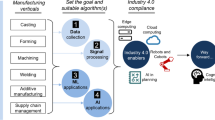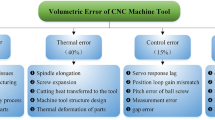Abstract
The real-time process fault detection in the multi-station assembly process is always a challenging problem for auto body manufactures. Traditionally, the fault diagnosis approaches for variation source identification are divided into two categories, i.e. the pattern matching methods and model-based estimation ones based on the collected data set. The measurements provide effective process monitoring, but the real-time process fault diagnosis in the assembly process is still difficult with the traditional diagnosis techniques, and always depends on the engineering experience in practice. Based on the assembly process knowledge, including multi-station assembly hierarchy, fixture scheme, measurement characteristics and tolerances etc. in the multi-station, a knowledge-based diagnostic methodology and procedures are proposed with the measurements of each body in white for part/component defections and faulty assembly station identification. For the station involved with defective parts/components, the sub-coordinate system of the part/component is established reflecting its position and pose in the space, and then the relative pose matrix to the “normally build” pose is calculated based on the deviations of sub-coordinates of the parts in this station. Finally, the assembly process malfunctions are determined by a proposed rule-based strategy with the relative pose matrix in real time. A simple 3 stations assembly process with 5 sheet metal parts was analyzed and compared with the traditional diagnostic method to verify the effectiveness and stability of the proposed method.











Similar content being viewed by others
Abbreviations
- S k :
-
The k-th assembly station
- C i, j :
-
The j-th part or sub-assembly in the i-th layer
- P i,j,m (a, b, c):
-
The deviation of the j-th part in the i-th layer in the form of m, and (a, b, c) represent the directions of the positioning elements control
- M ijp :
-
The p-th measurement characteristic of the j-th part/component that is firstly assembled in the i-th layer
- (x A, y A, z A):
-
The coordinates of the reference point A and the suffix of the x, y, z represents the corresponding reference point
- TR :
-
The tolerance of the RPFD
- \(n_{ij}^{{\prime }}\) :
-
The number of unqualified key product characteristics
- n ij :
-
The whole number of measurement characteristics on the j-th component of the i-th layer
- r ij :
-
The failure rate on the component
- r ij0 :
-
The threshold of the rij
- \(d_{ijp}^{c}\) :
-
The p-th RPFD of the j-th part in the i-th layer
- (x 0, y 0, z 0):
-
The measurement point near the four-way pin
- (u, v, w):
-
The origin of the sub coordinate system
- u/v/w :
-
The u/v/w axis of the sub coordinate system
- C ikj :
-
The j-th part in the k-th station of the i-th layer
- N ik :
-
Whole part/component number in the k-th station of the i-th layer
- \(\Delta x/\Delta y/\Delta z\) :
-
The differences in three translations along the coordinate axis
- \(\Delta \overset{\lower0.5em\hbox{$\smash{\scriptscriptstyle\frown}$}}{x} /\Delta \overset{\lower0.5em\hbox{$\smash{\scriptscriptstyle\frown}$}}{y} /\Delta \overset{\lower0.5em\hbox{$\smash{\scriptscriptstyle\frown}$}}{z}\) :
-
The difference in three rotations around the coordinate axis
- \(D_{j - l}^{ik 0}\) :
-
The nominal difference vector between the two parts when they are assembled in the “normal build” state
- \(D_{j - l}^{ik}\) :
-
The difference vector between the two parts
- \(\varepsilon_{j - l}^{ik}\) :
-
The threshold for the 2-norm of the difference vectors
- \(\varepsilon_{j - l}^{ikT}\) :
-
The threshold for the 2-norm of the translational difference vectors
- \(\varepsilon_{j - l}^{ikR}\) :
-
The threshold for the 2-norm of the rotational difference vectors
- V j−l :
-
The evaluation results of any two parts or components in the multi-station
References
Apley, D., & Shi, J. (1998). Diagnosis of multiple fixture faults in panel assembly. ASME Journal of Manufacturing Science and Engineering, 120(4), 793–801.
Yu, K., Jin, S., & Lai, X. (2009). Fixture variation diagnosis of compliant assembly using sensitivity matrix. Journal of Shanghai Jiaotong University (Science), 14(6), 707–712.
Camelio, J. A., Hu, S. J., & Yim, H. (2005). Sensor placement for effective diagnosis of multiple faults in fixturing of compliant parts. Journal of Manufacturing Science and Engineering, 127(1), 68–74.
Lawless, J. F., Machay, R. J., & Robinson, J. A. (1999). Analysis of variation transmission in manufacturing processes. Journal of Quality Technology, 31(2), 131–154.
Zou, C., Jiang, W., & Tsung, F. (2011). A LASSO-based diagnostic framework for multivariate statistical process control. Technometrics, 53(3), 297–309.
Shang, Y., Tsung, F., & Zou, C. (2013). Statistical process control for multistage processes with binary out puts. A IIE Transactions, 45(9), 1008–1023.
Jin, J., & Shi, J.(1999). State space modeling of sheet metal assembly for dimensional control. Journal of manufacturing science and engineering, 121(4), 756-762.
Wang, K., Du, S., & Xi, L. (2019). Three-dimensional tolerance analysis modelling of variation propagation in multi-stage machining processes for general shape workpieces. International Journal of Precision Engineering and Manufacturing. https://doi.org/10.1007/s12541-019-00202-0.
Ding, Y., Ceglarek, D., & Shi, J. (2000). Modeling and diagnosis of multistage manufacturing processes part I-state space model. In Proceedings of the 2000 Japan/USA symposium on flexible automation (vol. 7, pp. 23–26).
Tian, Z., Lai, X., & Lin, Z. (2004). Diagnosis of multiple fixture faults in multiple-station manufacturing processes based on state space approach. Journal of Tsinghua Science and Technology, 9(6), 628–634.
Yoo, Y. (2019). Fault detection of induction motor using fast fourier transform with feature selection via principal component analysis. International Journal of Precision Engineering and Manufacturing, 20(9), 1543–1552.
Mercorelli, P. (2017). A fault detection and data reconciliation algorithm in technical processes with the help of haar wavelets packets. Algorithms, 13(10), 1–13.
Kim, J., Lee, J., Kim, J., et al. (2010). Fault detection of cycle-based signals using wavelet transform in FAB processes. International Journal of Precision Engineering and Manufacturing, 11(2), 237–246.
Mercorelli, P. (2007). Biorthogonal wavelet trees in the classification of embedded signal classes for intelligent sensors using machine learning applications. Journal of the Franklin Institute, 344(6), 813–829.
Ding, Y., Shi, J., & Ceglarek, D. (2002). Diagnosability analysis of multi-station manufacturing processes. Journal of Dynamic Systems, Measurement, and Control, 124(1), 1–13.
Ding, Y., Zhou, S., & Chen, Y. (2005). A comparison of process variation estimators for in-process dimensional measurements and control. Journal of Dynamic Systems, Measurement, and Control, 127(1), 69–79.
Ceglarek, D., & Prakash, P. (2012). Enhanced piecewise least squares approach for diagnosis of ill-conditioned multistation assembly with compliant parts. Proceedings of The Institution of Mechanical Engineers Part B-Journal of Engineering Manufacture, 226(3), 485–502.
Mercorelli, P. (2007). Denoising and harmonic detection using nonorthogonal wavelet packets in industrial applications. Journal of Systems Science and Complexity, 3(20), 325–343.
Zhou, S., Ding, Y., Chen, Y., & Shi, J. (2003). Diagnosability study of multi-station manufacturing processes based on linear mixed model. Technometrics, 45(4), 312–325.
Apley, D., & Ding, Y. (2005). A characterization of diagnosability conditions for variance components analysis in assembly operations. IEEE Transactions on Automation Science and Engineering, 2(2), 101–110.
Ding, Y., Gupta, A., & Apley, D. (2004). Singularity of fixture fault diagnosis in multi-station assembly systems. Journal of Manufacturing Science and Engineering, 126(1), 200–210.
Chen, N., & Zhou, S. (2009). Detectability study for statistical monitoring of multivariate dynamic processes. A IIE Transactions, 41(7), 593–604.
Ceglarek, D., & Shi, J. (1996). Fixture failure diagnosis for auto-body assembly using pattern recognition. ASME Journal of Engineering for Industry, 118(1), 55–66.
Solis, R. G., & Prado, E. (2007). An Application of Dimensional Analysis Techniques in an Industrial. IEEE Latin America Transactions, 5(2), 76–80.
Liu, Y., & Hu, S. (2005). Assembly fixture fault diagnosis using designated component analysis. Journal of Manufacturing Science and Engineering, 127(2), 358–368.
Shan, X., & Apley, D. (2008). Blind identification of manufacturing variation patterns by combining source separation criteria. Technometrics, 50(3), 332–343.
Ceglarek, D., Shi, J., & Wu, S. (1997). A knowledge-based diagnostic approach for the launch of the auto-body assembly process. Journal of Engineering for Industry, 116(4), 491–499.
Du, S., & Xi, L. (2011). Fault diagnosis in assembly processes based on engineering-driven rules and PSOSAEN algorithm. Computers and Industrial Engineering, 60(1), 77–88.
Ko, J., Hong, S., Choi, J. Y., et al. (2013). Wafer-to-wafer process fault detection using data stream mining techniques. International Journal of Precision Engineering and Manufacturing, 14(1), 103–113.
Liu, Y., Sun, R., & Jin, S. (2019). A survey on data-driven process monitoring and diagnostic methods for variation reduction in multi-station assembly systems. Assembly Automation. https://doi.org/10.1108/AA-10-2018-0174.
Du, S., Lv, J., & Xi, L. (2010). An integrated system for on-line intelligent monitoring and identifying process variability and its application. International Journal of Computer Integrated Manufacturing, 23(6), 529–542.
Beruvides, G., Villalonga, A., Franciosa, P., et al. (2017). Fault pattern identification in multi-stage assembly processes with non-ideal sheet-metal parts based on reinforcement learning architecture. Procedia Cirp, 67, 601–606.
Dey, S., & Stori, J. A. (2005). A Bayesian network approach to root cause diagnosis of process variations. International Journal of Machine Tools and Manufacture, 45(1), 75–91.
Liu, Y., & Jin, S. (2013). Application of Bayesian networks for diagnostics in the assembly process by considering small measurement data sets. International Journal of Advanced Manufacturing Technology, 65(9), 1229–1237.
Acknowledgements
This project is supported by National Natural Science Foundation of China (Grant No. 51875362) and partly supported by SAIC General Motors Corporation.
Author information
Authors and Affiliations
Corresponding author
Additional information
Publisher's Note
Springer Nature remains neutral with regard to jurisdictional claims in published maps and institutional affiliations.
Rights and permissions
About this article
Cite this article
Liu, Y., Sun, R., Lu, Y. et al. A knowledge-based online fault detection method of the assembly process considering the relative poses of components. Int. J. Precis. Eng. Manuf. 20, 1705–1720 (2019). https://doi.org/10.1007/s12541-019-00218-6
Received:
Revised:
Accepted:
Published:
Issue Date:
DOI: https://doi.org/10.1007/s12541-019-00218-6




